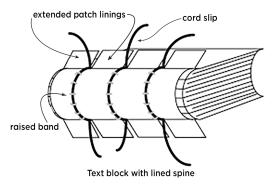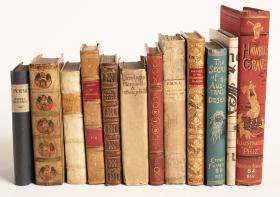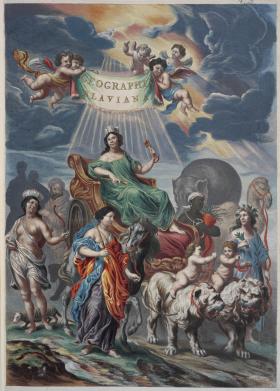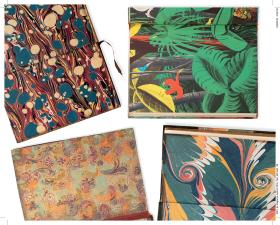In the earliest libraries, in medieval times, books were placed horizontally on shelves with their spines facing inwards.
But as more books were being produced in the sixteenth century, storage became a bigger challenge. More books could fit on shelves if they were upright and tightly packed together, which focused attention on the spine — the central support structure that holds the book together like the spine of the human body. A well-designed spine became an opportunity for booksellers to promote their publications, for binders to show off their skills, and for collectors to create the ultimate personal ‘shelfie’.
Before modern bookbinding, most books were held together by sewing the ‘gatherings’, or sets, of pages onto supporting strips of leather or cord. These strips were sometimes hidden by cutting grooves in the back of the text block made up of all the gatherings. In other books, the strips were left to stand out from the text block, so when the binding material was placed over the spine, the strips formed a series of ridges that bookbinders call bands.

The way in which the title is placed on the spine has also varied over time. From the sixteenth century, the title of a book appeared horizontally near the top of the spine, often abbreviated to fit. Sometimes the title was written or tooled directly onto the spine, or a paper label was used.
By the eighteenth century, it was common for a spine label to be made from a thin piece of coloured leather. The title and author’s name would be tooled in gold onto the label, which was then fixed to the spine.
Styles of spine decoration changed over the centuries, and in older collections it’s almost possible to date a shelf of books simply by examining them. But collectors should take care: the spine is the weakest point in a book’s structure. It might have been replaced due to overuse, or rebacked to suit the latest fashions in bookbinding. Colour-coding bookshelves may be fashionable today, but that’s hardly a challenge compared to arranging by leather type, lettering or golden lustre!
Maggie Patton is the Library’s rare books expert.
This story appears in Openbook Winter 2021.
Collection highlights

From L to R:
1. Marooned on Australia, 1896, by Ernest Favenc — pictorial cloth binding
2. The New Testament of our Lord and Saviour Jesus Christ, 1667 — leather binding with raised bands, each compartment with gilt fillets and tooling
3. Hunter’s historische Nachrichten, 1794, by John Hunter — marbled paper binding with printed paper label with gilt lettering
4. L’office de la Semaine Sainte, 1698 — red morocco with raised bands, compartments gilt tooled with fleur-de-lys motifs
5. Tales of the Old Regime and The Bullet of the Fated Ten, 1897, by Price Warung — pictorial paper binding
6. Les oeuvres de François Villon, 1723 — brown mottled calf with smooth spine, diagonal gilt fillets, creating a net effect, red and green leather labels
7. Breve trattato del mondo, et delle sve parti, semplici, et miste, 1571, by Giasone De Nores (16th Century) — original parchment smooth spine, handwritten title and shelf number
8. The Art of Warre, 1639, by the Lord of Praissac — plain leather with slightly raised bands, red label with gilt lettering
9. The Image of Bothe Churches: Hierusalem and Babel, vnitie and confusion, obedienc and sedition, 1623, by Matthew Pattenson — original plain vellum with slightly raised bands
10. The Golden Treasury, 1904, by Francis Turner Palgrave — red morocco with raised bands and ornate floral gilt tooling and title, by Riviere & Sons
11. L’art de nager, 1782 by Melchisédec Thévenot — brown leather with smooth spine, gold fillets and tooling creating a chevron pattern, red leather label

From L to R:
1. Poems, Epistles and Songs: chiefly in the Scottish dialect, 1788, by Robert Galloway — dark blue cloth binding with paper label
2. Idiomatologia anglo-latina, sive, Dictionarium idiomaticum anglo-latinum, 1690, by William Walker — smooth vellum spine, hand-painted compartments in orange, red, green and black tulip motifs
3. Poesie volgari: novamente stampate, 1554, by Lorenzo de’ Medici — original parchment with raised bands, red gilded label
4. Histoire des Sevarambes, peuples qui habitent une partie du troisième continent, communément appellé la Terre australe, 1715, by Denis Vairasse D’Allais — plain calf binding with raised bands, gilt fillets, red title and volume labels
5. Franciscii Xauerii Epistolarum libri quatuor, 1600, by Francis Xavier — brown calf with raised bands, gilt tooling, with compartments decorated with the initials I A M standing for French book collector Jacques-Auguste de Thou and his first wife Marie Barbancon
6. Chronologia historiae Herodoti et Thucydidis, 1573, by David Chytraeus — original vellum with smooth spine
7. Kim, 1942, by Rudyard Kipling — red leather with raised bands, gilt decoration, bound by Gordon Hughes, 1954
8. Emma: a novel, 1816, by Jane Austen — white paper spine with printed paper label
9. History of the Otaheitean Islands, 1880 — speckled calf with slightly raised bands, gilt tooling with thistle motif, red title label
10. The Secret of the Australian Desert, 1896, by Ernest Favenc — pictorial cloth binding
11. Sancti Prosperi presbyteri Aquitanici aduersus inimicos gratiæ dei libellus, 1524, by Prosper de Aquitania — smooth spine bound with recycled parchment fragment of medieval music
12. Hawbuck Grange or The Sporting Adventures of Thomas Scott, Esq., 1847, by the author of Handley Cross [RS Surtees] — pictorial red cloth binding illustrated by ‘Phiz’


![Vlyssis Aldrovandi patricii Bononiensis Serpentum, et draconu[m] historiae libri duo, 1640, by Vlyssis Aldrovandi](/sites/default/files/styles/max_width_280/public/vlyssis_aldrovandi_patricii_bononiensis.jpg?itok=lm5_a1Ys)

